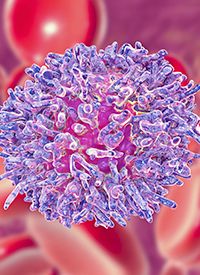Article
Zanubrutinib Responses Deepen Over Time in Relapsed/Refractory CLL
Author(s):
Zanubrutinib monotherapy showed a deepening of response in patients with relapsed/refractory chronic lymphocytic leukemia.

Zanubrutinib (Brukinsa) monotherapy showed a deepening of response in patients with relapsed/refractory chronic lymphocytic leukemia (CLL), according to long-term follow-up of the phase 2 BGB-3111-205 trial (NCT03206918) that were presented at the 2021 International Workshop on CLL.1
Data showed that at a median follow-up of 34 months, the objective response rate (ORR) by independent review classification with zanubrutinib in this patient population was 87.9%, reported lead study author Wei Xu, MD, in a poster presentation during the meeting.
“The median progression-free survival [PFS] has not been reached by the study close-out,” said Xu, who is chief of the Hematology Department, at The First Affiliated Hospital of Nanjing Medical University in China. The estimated progression-free survival (PFS) rate at 24 months was 80.5% (95% CI, 70.5%-87.4%), which remained at 68.1% (95% CI, 56.6%-77.2%) at 36 months.
Of note, “deep and durable responses were achieved in all patient subgroups, including patients with high-risk cytogenetics,” she said. “What was impressive is that all 20 patients with 11q deletion achieved a response, and the ORR in patients with 17p deletion and/or TP53 mutation was 91%.”
Of the 91 patients in the single-arm, multicenter study, 80 achieved a response by independent review committee, including 6 (6.6%) with a complete response, 63 (69.2%) with a partial response (PR), 11 (12.1%) with a PR with lymphocytosis; 3 (3.3%) patients had stable disease. Two patients were not evaluable due to missing anatomy imaging. “Prolonged lymphocytosis during treatment does not indicate a suboptimal PFS,” she said.
The median time to response was 2.79 months (range, 2.6-16.8) and the duration of response event-free rate was 83.4% (95% CI, 73.2%-90.0%) at 24 months and 69.9% (95% CI, 57.0%-79.6%) at 36 months.
“Results with longer follow-up continue to show a deeper response in more patients, including those patients with prolonged lymphocytosis,” said Xu. Over time, the ORR improved from 80.3% at a median of 9 months, to 84.6% at a median of 15 months, and 87.9% at the latest follow-up.
Patients with a confirmed diagnosis of CLL/small lymphocytic leukemia with an indication for treatment and who relapsed or were refractory after at least 1 prior therapy were eligible for enrollment into BGB-3111-205, which was conducted in China. All patients received zanubrutinib at 160 mg orally twice daily until disease progression or intolerable toxicity. The efficacy population consisted of 91 patients, 60 who completed treatment and 30 who stopped treatment due to progressive disease (n = 15), adverse events (n = 14), withdrawal of consent (n = 1), and principal investigator decision (n = 1).
The median patient age was 61 years (range, 35-87), and 69.2% had advanced-stage CLL. About three-fourths (74.7%) had prior therapy with an alkylator (including bendamustine), a purine analog in 57.1%, and an anti-CD20 antibody in 59.3% of patients. The median number of prior lines of therapy was 1 (range, 1-9). Seventy-two patients (79.1%) were refractory to their last therapy.
High-risk cytogenetics included IGHV-unmutated disease (56.0%), TP53 mutation and/or 17p deletion (24.2%), 11q deletion (22.0%), 13q deletion (45.1%), and trisomy 12 in (23.1%).
The authors noted that two-thirds of patients were still benefiting from continuous zanubrutinib at the time of data cutoff.
After 34 months of follow-up, the safety data are consistent with those previously reported. Neutropenia was the most common treatment-related adverse event (AE) reported, in 76.9% of patients, followed by upper respiratory tract infection (56.0%). Most laboratory AEs were low grade in severity (grade 1/2) without clinical consequences. One patient had atrial fibrillation that was grade 2.
Commonly reported treatment-emergent AEs leading to treatment discontinuation included pneumonia (n = 4) and hepatitis B (n = 2).
These data “support the tolerability of long-term zanubrutinib treatment in [relapsed/refractory] CLL/[small lymphocytic lymphoma], with no new safety signals identified,” Xu concluded.
Zanubrutinib is currently approved by the FDA for the treatment of patients with relapsed/refractory mantle cell lymphoma who have received at least 1 prior therapy, and also for the treatment of patients with Waldenström’s macroglobulinemia.
Reference
- Xu W, Yang S, Zhou K, et al. Zanubrutinib monotherapy in patients with relapsed or refractory chronic lymphocytic leukemia: 34-month follow-up results. Presented at: 2021 International Workshop on CLL; September 17-20, 2021; virtual. Abstract 1084090.




















